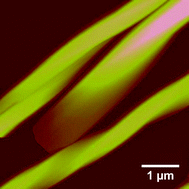Integration of self-assembled discotic-based fibres into field-effect transistors: a comparison of preparation approaches†
Abstract
The role played by the preparation method upon the morphological and electrical properties of

* Corresponding authors
a
Institut de Science et d'Ingénierie Supramoléculaires (ISIS)—CNRS 7006, Université de Strasbourg, 8 allée Gaspard Monge, Strasbourg, France
E-mail:
samori@isis-ulp.org
b Service de Chimie des Polymères, CP 206/01, Universités Libre de Bruxelles, Boulevard du Triomphe, Brussels, Belgium
The role played by the preparation method upon the morphological and electrical properties of

 Please wait while we load your content...
Something went wrong. Try again?
Please wait while we load your content...
Something went wrong. Try again?
R. C. Savage, J. M. Mativetsky, E. Orgiu, M. Palma, G. Gbabode, Y. H. Geerts and P. Samorì, J. Mater. Chem., 2011, 21, 206 DOI: 10.1039/C0JM01754J
To request permission to reproduce material from this article, please go to the Copyright Clearance Center request page.
If you are an author contributing to an RSC publication, you do not need to request permission provided correct acknowledgement is given.
If you are the author of this article, you do not need to request permission to reproduce figures and diagrams provided correct acknowledgement is given. If you want to reproduce the whole article in a third-party publication (excluding your thesis/dissertation for which permission is not required) please go to the Copyright Clearance Center request page.
Read more about how to correctly acknowledge RSC content.
 Fetching data from CrossRef.
Fetching data from CrossRef.
This may take some time to load.
Loading related content
